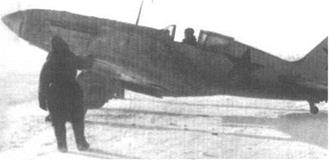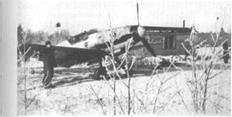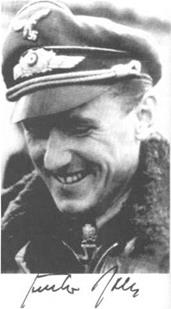The Soviet Counteroffensives
|
I |
n the southern combat zone, Marshal Semyon Timoshenko, the commander in chief of the Red Army’s Southwestern Zone, had brought forward strong Red Army reinforcements against the northern flank of the German First Panzer Army in Rostov. These forces were launched in an energetic counteroffensive during the last days of November 1941. The German lines immediately crumbled. The commander of Army Group South, Generalfeldmarschall Gerd von Rundstedt, decided to pull back his weakened units to a defensive position along the Mius River. Although this saved the First Panzer Army from being surrounded, it cost von Rundstedt his command.
The liberation of Rostov on November 30, 1941, was the first major success in the war with Germany. Contrary to the situation on the Moscow front, the VVS in the South could play only a minor role during this campaign. With the cream of the modern production program allocated to the defense of the capital, the Soviet airmen in the South were largely left with obsolescent aircraft models, such as the SB bombers, 1-16 fighters, and Polikarpov biplanes used in the ground-attack role. This inevitably resulted in considerable losses.
By early November Feldwebel Gerhard Koppen had scored the four-hundredth victory of Ill./JG 52. Four weeks later, Leutnant Adolf Dickfeld boosted the total past 500. During November, III./JG 52 registered only six Bf 109s lost with three pilots killed and one injured in this area. JG 77 contributed another sixty-five victories, against seven Bf 109s shot down in the Rostov sector during November. According to Soviet figures,
VVS-Southern Front recorded ninety aircraft as “total losses” in combat between November 1 and December l.2 The attrition of one of WS-Southem Front’s units, 590 ShAP, is typical of the overall situation. Equipped with eighteeen 1-153s on November 1, of which twelve were serviceable, this regiment registered nine aircraft totally lost and another severely damaged during combat missions in November.5 The units of VVS-Southwestem Front and the DBA regiments allocated to this sector suffered equally high losses. This fairly substantiates the German claims, whereas the claim of sixty-five German aircraft brought down by VVS-Southern Front during the same period must be regarded as somewhat exaggerated.
Nevertheless, the dogfights were not always one-sided. On November 28, 1941, Oberleutnant Gunther Rail, the Staffelkapitan of 8./JG 52, was shot down and badly wounded by an 1-16 lshak to the west of Rostov. At the time, Rail had been credited with thirty-eight victories. After returning to his unit less than a year later, Rail would rise to become the third-ranking fighter ace of World War II.
The weakness of the VVS in the southern combat zone is one of the main reasons why the Germans managed to hold out at the Mius line, fending off all Soviet attempts to break through.
On the Moscow front, the German Army made a final effort to seize the Soviet capital on December 2. Troops from the 258th Infantry Division actually managed to penetrate the Moscow suburb of Khimki, only – six miles from Red Square. General Armii Georgiy Zhukov dispatched all available forces, and bitter fighting raged on the ground and in the air above the battlefield.
On December 2 Soviet fighter pilots reported seventeen enemy aircraft shot down during forty aerial encounters in this area. Counted among the victims on the German side was the Staffelkapitan of 5./StG 1, Hauptmann Joachim Rieger. Bounced by Soviet fighters, Rieger’s wingman made a rash evasive maneuver and rammed his Staffelkapitan.4 Both Ju 87s went down. In 4./JG 52, Feldwebel Georg Brey was shot down and killed while strafing a Soviet truck column. In total, no more than four Luftwaffe aircraft were registered as lost during these combats, but the inflated claims made by the Soviet aviators during this period can be seen as a
|
|
Serving as an Oberleutnant and Staffelkapitan of 8./JG 52, Gunther Rail was one of the most skillful fighter aces on the Eastern Front. After shooting down his first Soviet aircraft as part of the air defense of Romania, Rail took an increasing toll of the VVS over the Ukraine in late summer and fall of 1941. On November 28,1941, he was shot down and badly injured. Although considered unfit for flying for the rest of his life, Rail struggled to regain his strength, and he returned to his unit in less than a year. When he left JG 52 to assume command of II./JG 11 in March 1944, Rail’s score of 273 victories put him in the first place among all fighter aces in the world. Shortly afterwards he was seriously injured in an aerial duel and ended the war as the world’s third ranking fighter ace, with a total of 275 victories. (Photo: Rail via Salomonson.) reflection of the high fighting spirit among the men in the VVS.
Northwest of the capital, the 11-2 Shturmoviks of 65 ShAP fell upon the columns of German troops retreat
ing from Yakhroma, claiming nearly a hundred vehicles destroyed on December 2. With their supply columns destroyed by repeated air attacks, Generaloberst Erich Hoepner’s and Generaloberst Hans Reinhardt’s Third and Fourth Panzer armies were forced to halt their offensives due to lack of fuel and ammunition—at a point not more than ten miles northwest of the Soviet capital.
In the air over the Kalinin battlefield, the MiG-3s of 129 IAP intercepted a Ju 88 formation on December 5, claiming five victories.
South of Moscow, Generaloberst Heinz Guderian’s Second Panzer Army had to discontinue its offensive against Tula on December 5, and it withdrew behind the upper Don River. The troops under Guderian’s command found themselves subjected to fierce aerial attacks, as described by historian Von Hardesty: “In the airspace around Tula, the WS frontal aviation under the command of another talented leader, [General-Mayor Fyodor] Falaleyev, made a forceful appearance. Here the WS targeted as its major goal the destruction of Guderian’s Second Panzer Army, now in retreat. In the Tula sector, the Stavka deployed a concentration of ground forces,
drawn from the Western and Southwestern fronts, which included the Fiftieth and Tenth armies plus some cavalry units. . . . Soviet air units made a valiant effort to destroy Guderian’s tanks.’’5
Generaloberst Guderian entered the following lines in his journal: “The offensive on Moscow has ended. All sacrifices and efforts of our brilliant troops have failed. We have suffered a serious defeat.”6
On December 6 both General-Polkovnik Konev’s Kalinin Front and General Armii Zhukov’s Western Front were pursuing the retreating enemy in what developed into a powerful counteroffensive.
As Hitler’s offensive against the Soviet capital succumbed under the hammer blows of counterattacking Red Army units, the Soviets were still numerically inferior to their enemy on the Moscow front—except in the air. The Soviet air superiority proved to be one of the most decisive factors. On December 6 the Soviets mustered 1,376 aircraft on the Moscow front, against fewer than 600 in Luftflotte 2/ But according to Zhukov, the main factor in the Soviet victory at Moscow was “the

This MiG-3, which is warming up on an airdrome near Moscow in the winter of 1941-42, is equipped with R/T, which until well into 1943 was quite uncommon in Soviet combat aircraft. (Photo: Seidl.)
 |
A 514 BAP Pe-2 being refueled at Makarovo Airdrome. The appearance of large numbers of Petlaykov’s modern dive-bomber over the battlefields outside of Moscow was of vital importance to the success of the Soviet counterattack. (Photo: Igashov/United State Museum of Tatarstan GOM RT.)
fantastic combat morale among the troops.” He wrote: “Our forces were absolutely convinced that they were going to defeat the enemy at the gates of Moscow."
This conviction was obvious not least among the Soviet airmen. A completely new fighting spirit appeared in the VVS units on the Moscow front. Von Hardesty wrote: “Despite poor weather—low’ clouds, fog, and snow’ storms—the WS covered the Soviet advance in force.”8
During these days, the modern Pe-2 bomber appeared in larger numbers over the front lines than ever before. The Pe-2-equipped 28 BAD launched ninety to a hundred sorties daily. On December 9 two Pe-2s of 23 SAD put ten enemy vehicles out of commission during three low-level attacks against a motorized column retreating from the Moscow Channel. The German Army Group Center fell back in disorder.
In air combat as well, the Germans ran into deeper trouble than ever previously on the Eastern Front. “The
Russian fighter pilots flew with a skill and courage that never had been experienced before,” notes the chronicle of JG 51.9 The loss rate in JG 51 of 32 percent during December 1941 reached its highest level since the outbreak of the war.
61AK/PVO claimed 170 German aircraft destroyed in November and another eighty in December. On December 13, five fighters of 43 SAD intercepted a bomber formation with fighter escort and shot down three German planes without any losses. On the same day, other Soviet aircraft struck the airfield at Klin, to the west of the Moscow’ Channel, where they destroyed a large number of Luftwaffe aircraft on the ground, including seven Bf 109s from II./JG 52.10
The entire Army Group Center was threatened with collapse. The contours of a total breakdown of combat spirit started to emerge. Generalleutnant Ferdinand Schaal, commanding the 56th Panzer Brigade, wrote: “A
growing number of soldiers started walking westward on their own initiative. . . . Victims of the aerial attacks weie no longer buried…. All kinds of equipment were abandoned in the general confusion.”
Unteroffizier Walter Todt of JG 52 describes the scene at Klin Airdrome during the disorderly retreat of I. and I1./JG 52 and a Ju 88 Staffel: “All of our aircraft, plus a Ju 88, and all fuel barrels were put together. An 8.8cm antiaircraft gun fired into the heap. Then the AAA was also blown up [becausel the engine of its towing vehicle refused to start. All German soldiers on the airfield entered the road to Russa on foot.”11
While inflicting severe losses on the Second Panzer Army, the Soviet Western Front advanced more than eighty miles in ten days. On December 16 Hitler issued his famous “halt order,” calling for a “fanatical resistance” without retreating another step. He fired both the head of OKH, Generalfeldmarschall Walter von Brauchitsch, and the commander of Army Group Center, Generalfeldmarschall Fedor von Bock, and took the former’s place personally while filling the latter vacancy with Generalfeldmarschall Hans Gunther von Kluge. The Fuhrer attempted to implement the same fear of reprisals among his army commanders as reigned on the Soviet side. Shortly afterwards he even dismissed the brilliant Panzer commander Generaloberst Heinz Guderian.
Hitler initiated hectic activity, turning to the Luftwaffe as the only remaining means to save the situation. The air force was lucky to escape changes in the command structure. On the contrary, it received immediate and
considerable reinforcements. Il./KG 54 Totenkopf was brought back from W’estem Europe along with three newly activated He 111 groups, forming KG 100 Wiking. Also rushed in from afar were the Zerstorer of I. and 1I./ZG 26, plus four air transport Gruppen with more than a hundred Ju 52s. One transport Gruppe was also transferred from Luftflotte 4. It was a last-minute effort, and it worked.
While the air transport fleet managed to improve the supply situation at the front, horizontal bombers, Stukas, and Zerstorer began to strike back at the advancing Soviet troops with a vengeance. On December 17, when the temperature had warmed to a mere minus – 1 З-degrees Celsius a large formation of Ju 87s surprised Zhukov’s spearheads west of Tula and reportedly destroyed thirteen tanks and about two hundred motor vehicles. A Ju 88 crew’ was even reported to have made a suicide attack against a lock gate in the Moscow Channel.12 The VVS still had numerical superiority; on December 18 it claimed the destruction of 340 trucks, 11 artillery pieces, 100 ammunition carts, and 3 trains. But merely seeing the reinvigorated Luftwaffe in the air overhead gave an imperative moral boost to the battered German ground troops. The Luftwaffe kept attacking the Soviet troops daily during the remainder of December, claiming four tanks and fourteen motor vehicles on December 18, seventy-five motor vehicles on December 21, four tanks and sixty’ motor vehicles on December 22, and two tanks and fifty’ motor vehicles on Christmas Eve.

 |
The challenge from the Soviet Air Force was met with airfield interdiction attacks. For example, Yeletz
Airdrome was bombed on December 23, and Aleksin Airdrome was hit on December 23, 24 (when two aircraft were destroyed on the ground), and 29 (when four aircraft were destroyed on the ground).
According to German sources, 119 Soviet and 33 German planes were shot down from December 15 to 30. Italian fighter pilots of Regia Aeronautical 22 Gruppo contributed by claiming twelve Soviet planes shot down between December 24 and December 26 for the loss of a single Mc.200 Saetta. On the Soviet side, VVS fighters on the Moscow battle scene claimed sixteen aerial victories between December 17 and December 26.l! On Christmas Eve PVO ace Starshiy Leytcnant Gerasim Grigoryev of 178 IAP claimed a Ju 88 with his LaGG-3, which raised his total score to eleven personal and two shared victories.
Within two weeks, the destructive blows from the air managed to take the wind out of the Soviet counteroffensive. But the wind of Operation Typhoon had also subsided definitively. By New Year’s Eve the prime objective of the Soviet counteroffensive—to throw back the threat against Moscow—had been achieved. Operation Barbarossa was dead.
It had been a swift and dramatic turning. From November to December 1941, the major task of the W’ehrmacht on the Eastern Front shifted from an offensive aimed at the destruction of the USSR to a defensive mode aimed at saving itself from collapse. The air forces of both sides played a significant role during the Battle of Moscow in December 1941.
Even if inadequate supplies, short resources, and battle fatigue on the German side wrere the main factors behind the Soviet victory, the contributions of the VVS itself should not be underestimated. According to Soviet sources, VVS units mounted roughly 16,000 combat sorties in the Moscow area between December 6, 1941, and January 7, 1942.14 It is clear that the Soviet Air Force was a major contributor to the German defeat outside Moscow. In spite of the heavy commitment, the Soviet losses in the air decreased remarkably during this period. The loss rate dropped below 1 percent for the first time in the war. According to VVS statistics, no more than 140 Soviet aircraft were lost during the Moscow offensive from December 5, 1941, to January 2, 1942.15
General Armii Zhukov later wrote: “Our air units – those belonging to the [Western] Front, as well as those of the Air Defense and the Long-Range Air Force—gave an important contribution to our counteroffensive at Moscow – in December 1941. The airmen put up a skillful and courageous fight. For the first time since the outbreak of the war, our fliers deprived the enemy of his superiority in the air. Our air force maintained a systematic pressure against artillery positions, tank units, and command posts. And as the Nazi armies started retreating, our aircraft attacked and bombed the withdrawing troops without interruption. This resulted in all roads to the west becoming littered with equipment and vehicles abandoned by the Germans.”16
Even if they were better trained and better equipped, the once proud Luftwaffe airmen simply had lost the war of exhaustion with their Soviet counterparts. Wolfgang Dierich gives the following account of the situation in KG 51 at this time: “In their medical journals, the air force medics Dr. Denkhaus (1./KG 51) and Dr. Ott (III./KG 51) repeatedly noted ‘severe nervous exhaustion’ among the airmen, with symptoms such as crying attacks, extreme sensitivity and even epileptic attacks.”17
For all that, the Luftwaffe had been able to maintain its role as the trump card of the W’ehrmacht. Hitler’s “halt order” and the increased Luftwaffe activity saved Army Group Center from complete annihilation in December 1941.
It is highly questionable that the seizure of Moscow really would have ended Soviet resistance (which was what the German High Command—and to a certain degree, even several Western historians today—anticipated). Nevertheless, the rescue of Moscow wras of enormous importance to the entire Soviet population and created the psychological preconditions for the extended defensive battles during the following difficult year, which in turn would lead to the final strategic turning point of the war.











